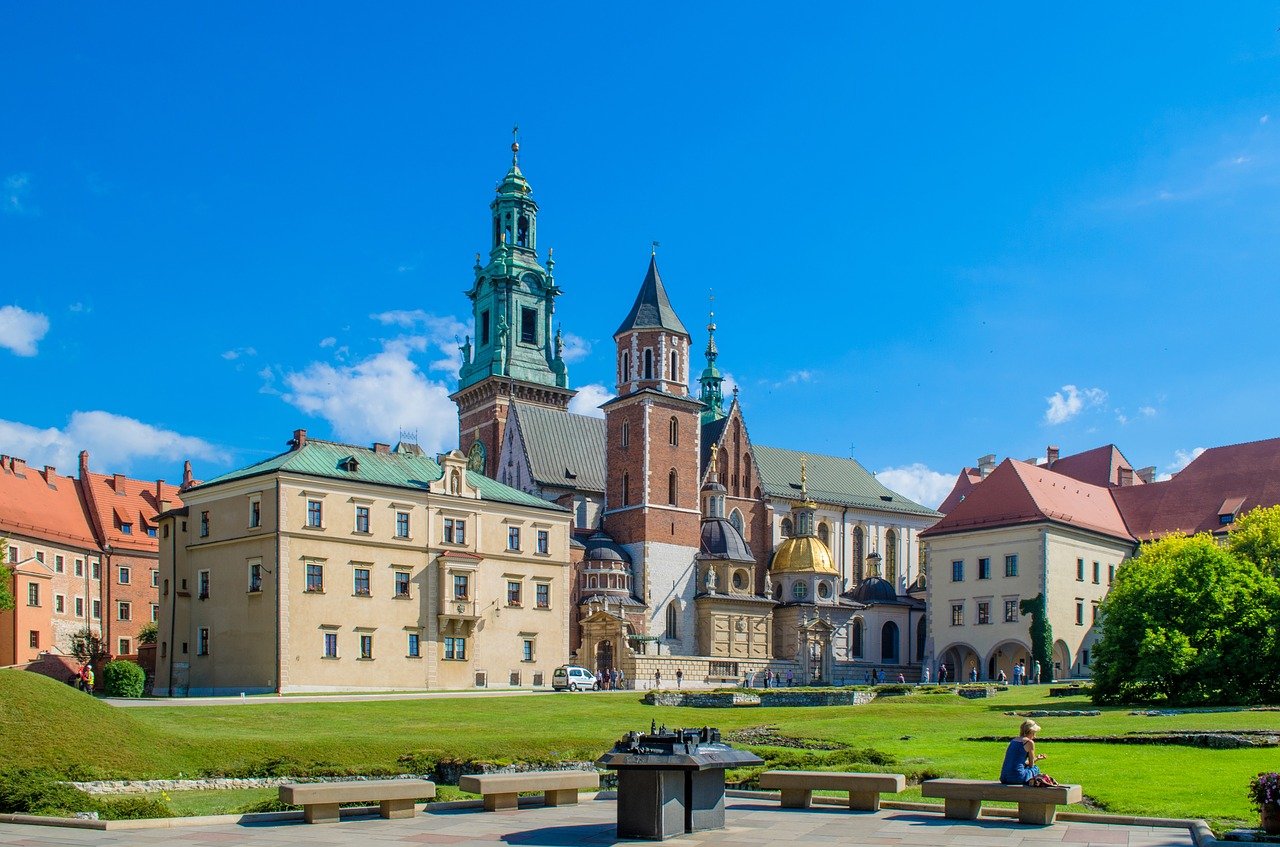From Poland and the Poles by Alexander Bruce Boswell, 1919.
Poland has always been a rich field for the development of all the arts, owing to her close connexion with Western Europe and to the artistic talents of her sons. Over a long period there could be little permanence for architecture in a country where the chief building material was wood, and where constant raids by the Tartars and invasion by Swedes, Turks and Muscovites devastated the country and exhausted its resources in man-power. Yet from the time of the arrival of the Benedictine and Cistercian monks in the eleventh century, architecture began to flourish, and soon music, sculpture and painting rose, often imitative, but often original, and showing strongly marked national features of their own.
The history of the famous Wawel, that revered centre of national life, that has survived long eras of calamity, and still holds its proud, regal position in Cracow, is symbolic of the persistence of art in Poland. The Wawel is the Acropolis or Kremlin of Cracow, and contains both the Royal Castle and the Cathedral. The original cathedral has passed through many phases. It was originally a Romanesque structure, of which only a crypt remains; then a magnificent Gothic building took its place; and, lastly, the famous Renaissance Chapel was added to it.
The Castle is one of the finest specimens of Renaissance architecture in Europe. There are several specimens of Romanesque architecture still preserved elsewhere, but the glory of mediaeval Poland lies in the later buildings which grew up in the "Vistula Gothic" style, a variation of ordinary Gothic, distinctive in its use of brick, its bizarre combinations of brick with stone, its slender lines and the great length of its choirs. The Cathedrals of Cracow, Warsaw and Vilna are all splendid examples of this style, while in its more secular aspects we have the Cloth workers' Hall, the University Library and part of the Town Hall (Polish, Ratusz) at Cracow, the Cathedral School at Przemysl and a number of stately buildings all over the country. The gate of St Floryan and the Barbican at Cracow, dating from the fifteenth century, are almost unique monuments from this period.
The Renaissance has left many splendid buildings in Poland, especially in the work of the municipalities: the Town Halls of Poznan and Dantzig, the Old Town at Warsaw, the Market-places and arcades of Cracow and Lemberg. The palaces and country mansions of the gentry, some copied from the Renaissance style of the Wawel, but most of them in the later Barocco, Rococco and Empire styles, cover the whole country, especially Lesser Poland.
More national elements are seen in the buildings of wood, which were erected from local material to suit local needs, and so have a distinctive quality of their own, dating from pagan times. A modern revival, based on peasant art, shows especially the influence of the Tatra mountain region, where a national style of architecture has grown up, known as the "Zakopane" style. The adornment of the Polish churches, with all the magnificence of the Catholic tradition, led to a great development of sculpture, culminating in the work of Wit Stwosz in the sixteenth century. He studied at Nuremberg, and returned to found a school at Cracow and to beautify all East Central Europe with his superb masterpieces in wood and bronze. At a later day, Thorwaldsen founded a school of Polish sculptors, and left to Poland his magnificent statues of Copernicus and Prince Joseph Poniatowski.
Painting and music also flourished in Poland, largely under Italian influence; and, at the time of the Renaissance, Poland was behind no country in Europe in her musical productions, especially in church music. The Kolendy, or Christmas Carols, of Poland are especially beautiful; and there is a long tradition of church music, from the introduction of Gregorian chants by St Adalbert to the hymns and masses of later times.
But modern music and painting in Poland are of more recent origin. They owe their revival to their cultivation at the magnificent Court of Stanislaw Poniatowski, the last king, a man of weak character but of lofty aesthetic ideals. He drew on all Europe in his quest for artists and teachers. His master of the revels was the painter Bacciarelli, and he also summoned to his Court such celebrated artists as Canaletto, Lampi, Grassi, Fuger and Norblin. Among the Polish artists of the day were Chodowiecki and Kucharski, whose pictures of Marie Antoinette and Countess Potocka are well known. These men left a school of classical painters, chief among whom were Smuglewicz and Orlowski. The King also created a national opera. Paisiello was his master of music; and a number of operas were composed by Stefani, Kurpinski, and Eisner, who became Director of the Warsaw Conservatoire, and was the teacher of Chopin.
Boswell, Alexander Bruce. Poland and the Poles. Methuen, 1919.
About TOTA
TOTA.world provides cultural information and sharing across the world to help you explore your Family’s Cultural History and create deep connections with the lives and cultures of your ancestors.


